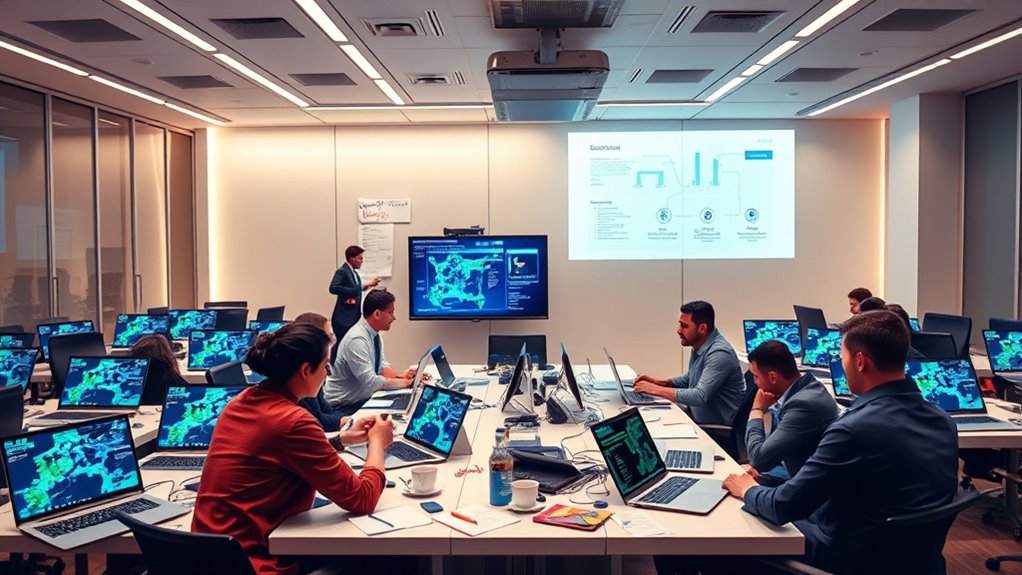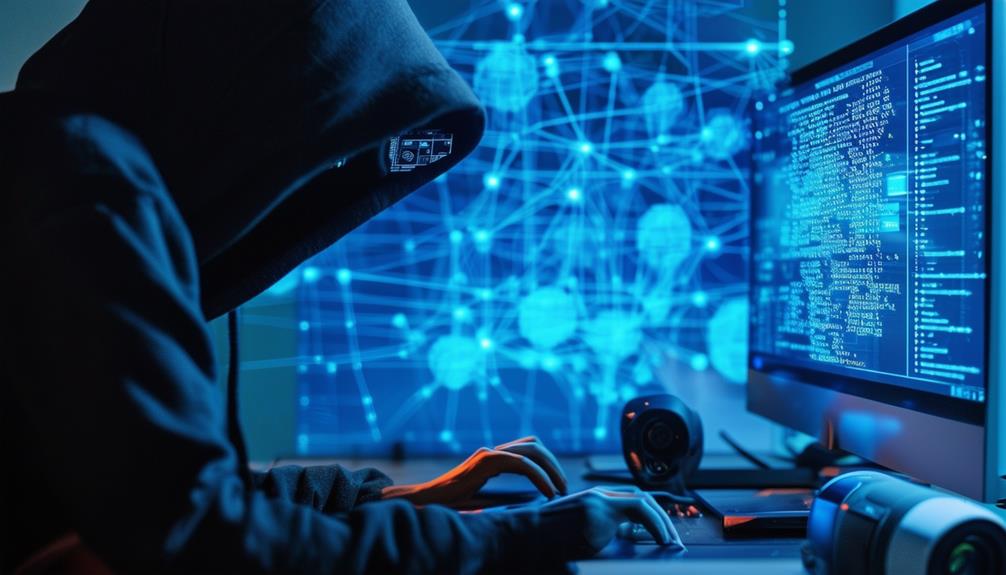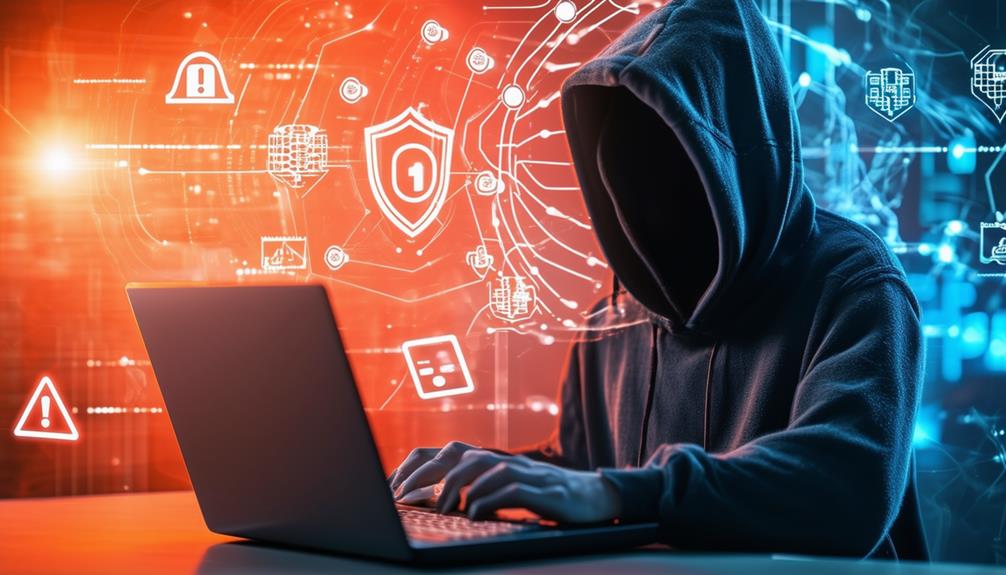To set up a CTF event to train your security team, first define clear goals and identify your target audience. Choose suitable formats and design challenges that reflect real-world threats, ensuring they vary in difficulty. Prepare a secure infrastructure with scoring systems and submission portals. Promote your event through various channels and run test sessions to iron out issues. If you keep exploring, you’ll learn how to create a compelling and effective cybersecurity training experience.
Key Takeaways
- Define clear training objectives and tailor challenges to match your security team’s skill levels and real-world scenarios.
- Design a balanced challenge set across categories like cryptography, web, reverse engineering, and forensics for comprehensive skill development.
- Ensure a secure, scalable technical infrastructure with isolated environments, reliable scoring, and real-time monitoring.
- Establish clear rules, scoring systems, and communication channels, promoting fairness and transparency during the event.
- Conduct thorough testing and post-event analysis to improve challenge quality, infrastructure stability, and team feedback integration.
Defining Your Goals and Target Audience for the CTF
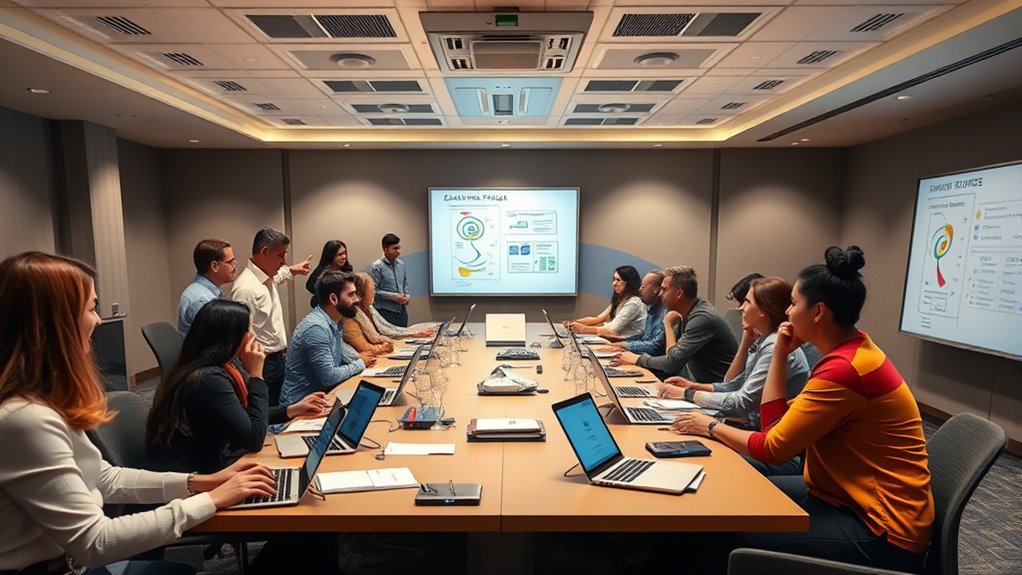
Before planning your CTF event, it’s essential to clearly define your goals and identify your target audience. Your goals might include improving cybersecurity skills, promoting teamwork, or simulating real-world scenarios to prepare participants for actual threats. Consider whether you want to focus on talent development, community engagement, or organizational security enhancement. Knowing your audience helps tailor the challenges and complexity level. For example, students and enthusiasts seek practical experience, while professionals and government personnel look for advanced skills. Understanding who will participate ensures your event aligns with their needs and expectations. Setting clear objectives and knowing your audience from the start guides your challenge selection, resource allocation, and overall event design, making your CTF more effective and impactful. Color accuracy and contrast ratios are also important factors in creating engaging visual displays for presentations and displays during your event. CTFs serve as practical tools for learning, skill validation, and community engagement, allowing organizers to better meet the diverse needs of participants.
Selecting the Appropriate CTF Format and Challenge Types
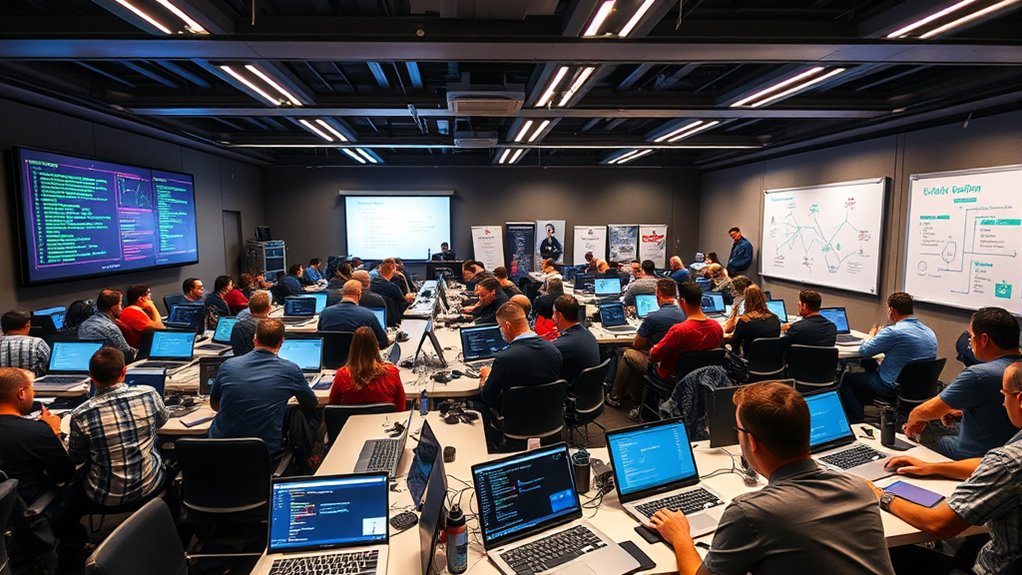
Choosing the right CTF format and challenge types is essential for creating an engaging and effective event. If you want variety, consider Jeopardy-style CTFs with categorized challenges across different skills, or attack-defense formats that simulate real-time attacks and defenses, encouraging teamwork and strategy. Mixed-style formats combine these approaches for a thorough experience. Tailor the event structure to match your participants’ skill levels and training needs, offering flexibility and customization. When selecting challenge types, include cryptography, web security, reverse engineering, forensic analysis, and miscellaneous puzzles to cover a broad spectrum of cybersecurity topics. Incorporating a mix of difficulty levels and real-world scenarios keeps participants motivated and learning. Properly choosing the format and challenges ensures your event remains engaging, relevant, and aligned with your training goals. Additionally, consider integrating challenges that develop practical skills like network analysis and digital forensics to enhance real-world preparedness. For optimal planning, be aware of support hours and schedule your event accordingly to maximize participation and support.
Designing Engaging and Relevant Challenges
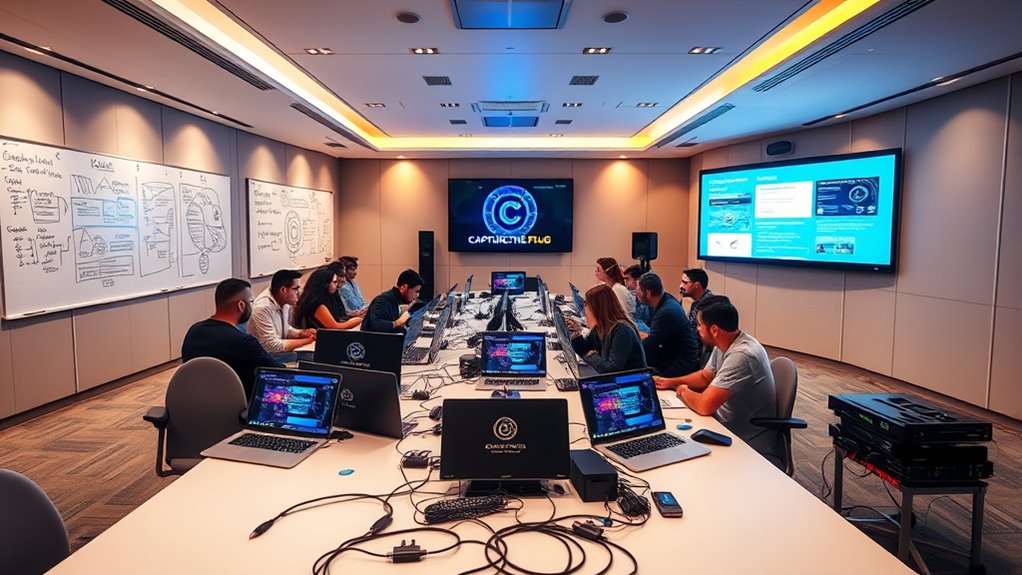
To keep participants engaged, you need to design challenges that are diverse in scope and difficulty, matching different skill levels. Make sure your challenges stay relevant by reflecting current cyber threats and attack techniques. Balancing challenge difficulty prevents frustration and encourages continuous learning, keeping the event both challenging and accessible.
Challenge Diversity and Scope
Designing engaging and relevant challenges for a CTF requires balancing variety, difficulty, and educational value. To do this, focus on creating challenges that teach applicable skills in real-world contexts, such as cryptography, network analysis, or web security. Incorporate novelty to foster creativity and surprise, making the experience memorable. Guarantee the challenges mirror real cyberattack scenarios, like encryption flaws or misconfigurations, to increase authenticity. Additionally, understanding core personality traits, such as resilience and adaptability, can help in designing challenges that encourage participants to develop these essential cybersecurity qualities core personality traits. Consider these key points:
- Include a mix of web, network, crypto, and forensics challenges to cater to diverse skill sets.
- Offer varying difficulty levels, from easy to hard, to accommodate all participants.
- Provide clear instructions and enough context to prevent confusion and enhance learning.
Relevance to Current Threats
How can you guarantee your Capture the Flag (CTF) challenges stay relevant in today’s rapidly evolving cybersecurity landscape? By aligning challenges with current cyber threats like supply chain attacks and emerging malware strains, you ensure participants stay engaged with real-world issues. Incorporate industry-specific scenarios and real-time threat updates, making challenges more authentic. Using threat intelligence reports and collaboration with cybersecurity experts helps keep challenges current and practical. Dynamic challenge generation and feedback loops from participants enable you to adapt quickly. Integrating emerging technologies like AI, cloud security, IoT, and cyber range simulations reflects modern infrastructure and attack vectors. These strategies ensure your CTF remains meaningful, effective, and directly applicable to current cybersecurity challenges. Staying updated on the latest trends is essential to maintain the relevance and challenge level of your event.
Balancing Difficulty Levels
Balancing difficulty levels in a Capture the Flag event is essential to keep participants motivated and engaged across different skill sets. To achieve this, you should establish appropriate difficulty gradations, typically including easy, medium, hard, and extreme tasks. A common distribution is 35% easy, 35% medium, 25% hard, and 5% extreme, which promotes broad participation and progression. Be aware that difficulty calibration can be tricky; some “easy” tasks may unexpectedly challenge participants, while hard tasks might be solved quickly. To maintain engagement, consider:
- Using sequential challenge design to control difficulty progression
- Implementing dynamic or bell curve scoring systems for fairness
- Including diverse challenge types reflecting various expertise areas
- Ensuring themes are relevant to current exploits and research(relevance), which helps keep scenarios engaging and educational.
This approach ensures challenges remain challenging yet achievable, fostering growth and learning.
Planning the Infrastructure and Technical Setup
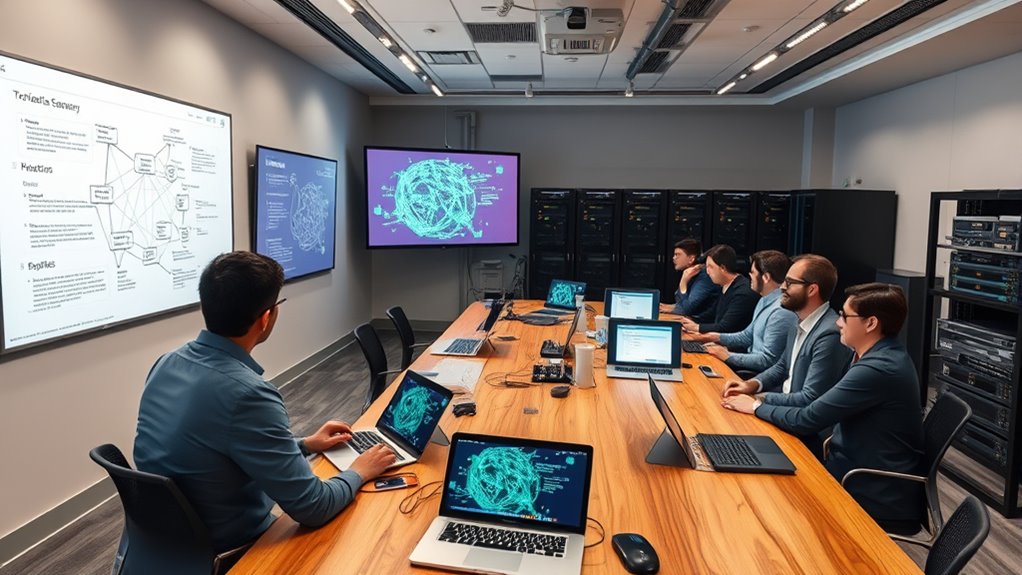
Effective infrastructure and technical setup are crucial for running a successful Capture The Flag (CTF) event. You need to guarantee participants have personal computers with administrator or sudo access to install necessary tools. Virtual machines like Kali Linux or Windows images help isolate the CTF environment from personal systems, reducing risks. Allocate sufficient storage for challenge files and tools such as Wireshark, Ghidra, Hashcat, and BurpSuite. Consider browser-accessible VMs for those with hardware or policy restrictions. Set up a platform supporting user registration, team management, real-time flag validation, and scoring. Host virtual machines for complex challenges in controlled environments, and use cloud solutions like AWS or Azure for scalability. Implement secure network configurations, monitor activity, and prepare fallback plans to ensure smooth, uninterrupted gameplay. Proper network security measures are essential to prevent unauthorized access and attacks during the event. Additionally, ensuring secure data handling can help protect sensitive information and maintain participant trust throughout the competition.
Developing Rules, Guidelines, and Fair Play Policies
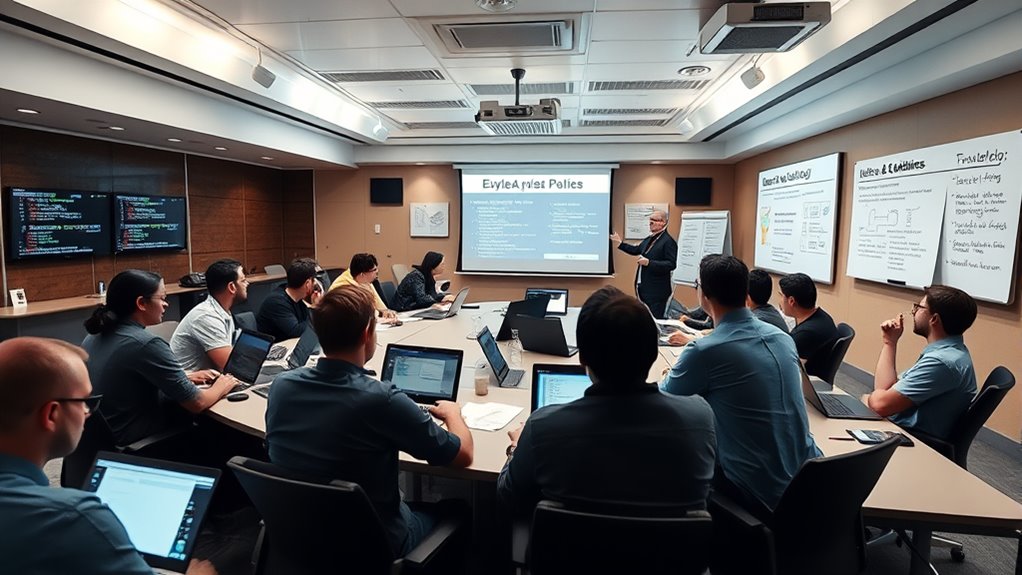
Establishing clear and thorough rules is essential to guarantee fairness and smooth operation during your CTF event. Your rules should clearly define what actions are permitted and forbidden to prevent disruptions and ensure everyone competes on equal footing. A well-defined rule set helps participants understand expectations and reduces misunderstandings during the competition. – Specify in-scope targets like IP addresses and ports to avoid unintentional issues. – Prohibit actions that intentionally hinder other participants, maintaining a learning-focused environment. – Provide detailed instructions for challenge submissions, support contacts, and event procedures. Make these rules available beforehand and communicate any updates promptly. Encourage open dialogue for questions and clarifications. Regularly review and refine your policies to adapt to new challenges, ensuring your CTF remains fair, educational, and engaging for all participants. Additionally, understanding the offensive security measures involved can help in crafting realistic and effective challenge scenarios.
Setting Up the Score Tracking and Submission Systems
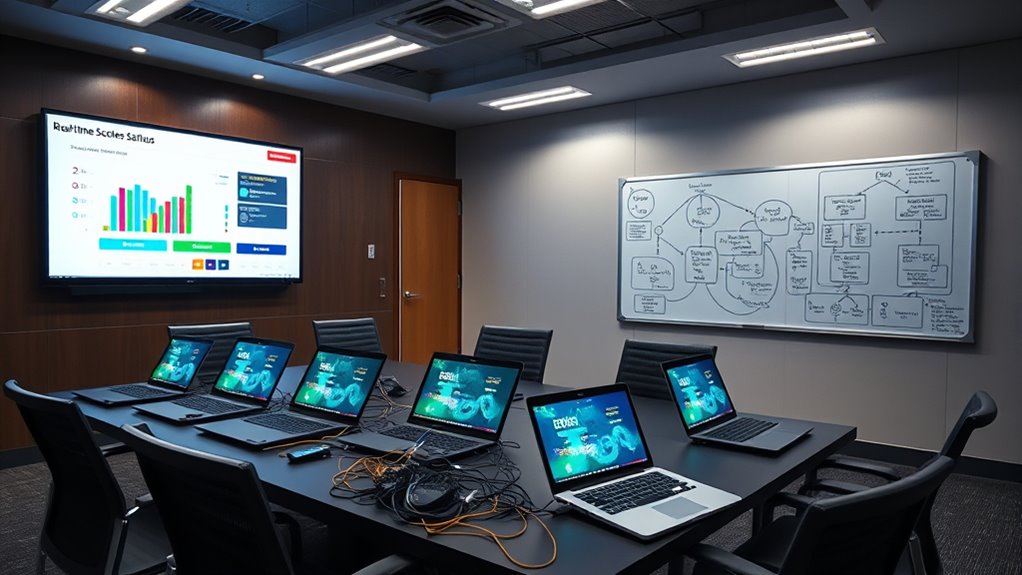
Setting up a reliable score tracking and submission system is essential for maintaining fairness and transparency during your CTF event. You’ll want a centralized score-tracking server to manage registration, leaderboards, and challenge statuses, accurately recording who solves what and updating scores instantly. Use a consistent secret key for flag validation, ensuring flags are verified uniformly across all participant instances. Incorporate a web interface allowing participants to enter flag codes manually, reducing dependency on runtime servers. Support various deployment environments like Node.js, Docker, or cloud platforms to keep scoring flexible and scalable. Integrate real-time scoring with intrusion detection systems, providing detailed attack alerts and score breakdowns. Employ web-based dashboards with caching to handle high query loads, ensuring smooth, fast score updates and submissions throughout the event. Additionally, implementing secure communication protocols can help protect sensitive data during transmission and prevent tampering.
Preparing for Event Promotion and Participant Recruitment
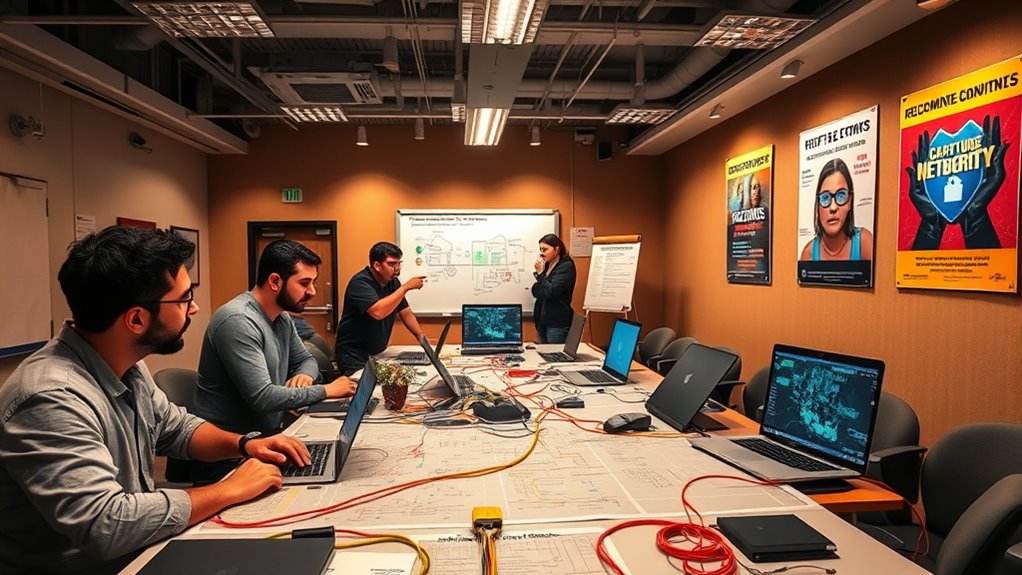
To attract the right participants and generate excitement for your CTF event, you need a clear plan for promotion and recruitment. Begin by defining your target audience—beginners, intermediates, or experts—and tailor your messaging accordingly. Use various promotional channels like social media, email campaigns, and cybersecurity communities to spread the word. Building strong partnerships with organizations can expand your reach and add credibility. Consider offering attractive prizes or incentives to motivate participation and create buzz. Additionally, develop a dedicated event website with registration details, schedules, and updates to streamline sign-ups and keep participants engaged. Focus on clear, targeted messaging that highlights the event’s purpose, challenges, and rewards to maximize interest and ensure you attract a motivated, relevant audience. Effective promotion is essential for ensuring a diverse and engaged group of participants who are eager to learn and compete. Incorporating anime movies that touch hearts or engaging storytelling techniques can also inspire participants and enhance the overall experience.
Conducting Pilot Tests and Final Preparations

Conducting thorough pilot tests is essential to guarantee your CTF environment runs smoothly on event day. First, set up a working copy of the contest in your planned environment, like AWS or Azure, and verify each challenge functions correctly. Involve your test team to identify issues early and gather feedback to improve both challenges and the overall experience. Perform infrastructure stress tests to ensure the system can handle the expected number of participants, checking scalability and security measures. Confirm user login processes are seamless, and ensure challenge hosting platforms are reliable. Prepare support channels, such as chat or forums, for participant assistance. Address technical issues proactively by establishing issue reporting and backup systems, minimizing potential disruptions during the event. Effective testing helps uncover unforeseen problems and ensures a positive participant experience.
Post-Event Review, Feedback, and Future Planning

After hosting your CTF event, reviewing participation metrics, engagement data, and participant feedback is essential for understanding what worked well and where improvements are needed. This helps you identify strengths and gaps, guiding future efforts. Focus on:
- Analyzing challenge completion rates and segmenting performance by topics to spot skill gaps.
- Collecting qualitative feedback on event logistics, platform usability, and challenge difficulty to refine your approach.
- Creating detailed reports that connect outcomes to your training goals, highlighting successes and areas for improvement.
- Remember that CTFs mimic real-world attack scenarios, providing valuable experience for offensive and defensive skills that can directly translate to actual cybersecurity challenges.
- Additionally, reviewing the overall event impact can help measure how your training aligns with organizational security objectives and assess the broader effectiveness of your cybersecurity initiatives.
Use these insights to make informed adjustments, such as balancing challenge difficulty, upgrading infrastructure, or improving participant recruitment. Sharing findings with stakeholders maintains transparency and support, ensuring continuous improvement and more effective future events.
Frequently Asked Questions
How Can I Ensure the Security of the Challenge Infrastructure During the Event?
To guarantee your challenge infrastructure stays secure, you need to implement controlled environments like virtual machines, isolate individual challenges, and keep communication channels secure. Regularly conduct security audits and monitor systems continuously for suspicious activity. Enforce secure configurations, use threat detection tools, and follow risk management frameworks like NIST CSF. Additionally, ensure compliance with policies and provide support to participants, reducing vulnerabilities during the event.
What Are the Most Effective Ways to Motivate Participants Throughout the CTF?
Imagine opening team potential with exciting motivation strategies. To keep participants engaged, offer a mix of tangible rewards like swag or bonuses, and intangible perks such as badges and recognition. Use real-time leaderboards to spark friendly competition, and share success stories to inspire continued effort. Regular hints, progress updates, and follow-up learning sessions help maintain momentum, turning participation into a rewarding experience that fosters growth and enthusiasm throughout the event.
How Do I Handle Technical Issues or Disputes During the Competition?
When dealing with technical issues or disputes, you should have a detailed troubleshooting guide and clear response plans ready. Keep communication channels open to receive reports quickly, and monitor systems actively. Train your support team thoroughly so they can respond swiftly. For disputes, establish transparent rules and a neutral review process. Prioritize fairness, communicate updates promptly, and have backup solutions in place to minimize disruption and maintain trust.
What Tools or Platforms Are Recommended for Managing Team Collaboration?
Managing team collaboration in a CTF is like orchestrating a symphony of cybersecurity talents. You should consider platforms like CTFd for customizing challenges and tracking progress, or Hack The Box for seamless event setup and team management. For ongoing training, TryHackMe offers collaborative learning paths, while CTFtime helps coordinate multiple events. These tools streamline communication, enhance teamwork, and keep everyone synchronized, making your CTF a well-oiled machine.
How Can I Measure the Long-Term Impact of the CTF on Team Skills?
You’re looking to measure the long-term impact of CTFs on your team’s skills. Focus on tracking progress through regular assessments, comparing scores across multiple events, and reviewing challenge completion rates. Use tools like CTFd to gather data over time, and set clear, measurable goals aligned with industry frameworks. Collect feedback from team members and monitor real-world performance improvements, such as faster incident responses or increased vulnerability detection, to gauge sustained growth.
Conclusion
By clearly defining your goals, selecting the right format, designing engaging challenges, and preparing thoroughly, you’ll create a memorable CTF event. You’ll motivate participants, foster teamwork, and strengthen skills. You’ll refine your infrastructure, streamline your processes, and gather valuable feedback. You’ll celebrate successes, learn from challenges, and plan improvements. Ultimately, you’ll build a resilient security team, a vibrant community, and a foundation for ongoing growth—all through thoughtful planning and dedicated effort.
